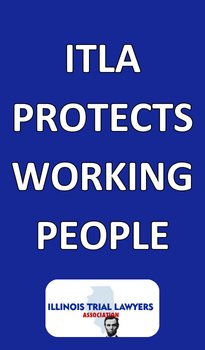* Gov. JB Pritzker at his media briefing today…
Although nearly half of those who have been tested did not fill out their demographic information, of those who did 7.6% self-identified as Hispanic. Of these, more than 26,000 individuals, nearly 16,000 of them have tested positive for COVID-19. That’s a positivity rate of 60%. That’s nearly three times our state average.
As a point of comparison, for the half of people who left their race blank on their forms, about 18,000 tested positive for the virus. That’s 10%. We don’t know what portion of those unknowns might also qualify as Hispanic or Latinx. But what we do know is that our data from the start, until today, shines a concerning spotlight on which of our residents are most likely to get sick from COVID-19.
Remember to pardon all transcription errors.
* More from the governor…
Decades of institutional inequities and obstacles for members of our Latinx communities are now amplified in this pandemic. And while we can’t fix generations of history in the span of a few months, we must advance equity in our public health response today, everywhere and anywhere we can. My administration has made it a priority to enter into testing partnerships in as many areas around the state as possible, with a focus on communities, home to significant populations who are more vulnerable to this virus. We now have over 200 public testing sites in Illinois, a third of which are located in communities with a significant Latinx population, measured here as greater than or equal to 17%, which is the Latino population number statewide. […]
Of the seven drive-thru sites that the state does formally run, each offers bilingual support for Spanish speakers. And as we build on our existing contact tracing abilities at local health departments, we will continue to make a push for robust relationships with trusted partners in Latino communities and ensure our tracking capabilities reflect Illinois multilingual diversity.
* More…
At this time, face coverings are required in public situations where social distance cannot be maintained. And that applies only to those who are medically able to wear a mask.
I recognize that this is a new practice for many in Illinois and the entire United States, but it’s on us to change how we think about face coverings. Protecting your fellow Americans by wearing a face covering in public is a collective act of patriotism. And doctors will tell you it’s one of the best things that we can do for public health right now. There have been reports of misplaced assumptions about masks, leading to incidents of racial profiling against Latinx,and black Americans, especially men, as well as you know phobic attacks against Asian Americans. And I want to call on the public to help us stop these hateful incidents by speaking out and standing up for others in your community. If you witness or experience mask-related discrimination or any form of discrimination, please report the incident to the Illinois Department of Human Rights
* On to questions for the governor. Governor, what would you say to those who say Democratic governors are trying to keep their states closed for as long as possible in order to make better cases for federal bailout funds?…
I can only speak for this Democratic governor and I certainly have talked to enough, a number of others and I’ll just say that we are listening to the scientists and the epidemiologists, the doctors about what’s best for the people who live in our states. And that’s what we’re doing all of us. Indeed, I’ve talked to many of the governors across the nation. They have shared their epidemiological findings, as well they’re experts with us, and we have terrific ones here that we’ve shared with them.
* Can the governor provide more clarity to churches regarding holding services, should they plan not to hold services larger than 50 people until their region has moved to phase five?…
Well you know that in phase three there can be gatherings church gatherings of 10 or fewer and phase 4 is 50 or fewer. So that’s the guidance that’s been given to me. I’m not the one providing that guidance, it really is what the scientists and epidemiologists are recommending.
* As an entrepreneur at heart could you talk about what areas of business and industry you see emerging post pandemic and how they might benefit state government?…
That is really interesting. So I guess I’ll just say that I think there are going to be a number of new businesses that get started as a result of this. I think you’ve already seen that at least before there is a vaccine. There are lots of entrepreneurs who have started mask and face covering businesses, others who are trying to address the medical needs that are associated with people who are in isolation, or people who are COVID positive. And of course, I think there’s no question there’s going to be an advanced effort to provide to make sure that we are ready for the next pandemic, and all the things that may be required for that whether it’s technology on your iPhone or other device, or making sure that we’re, you know, producing the PPE in the United States that will be available. So I think there’s there’s an awful lot that I can see happening after this pandemic is over.
* We’ve heard reports saying IDPH has hospital resource numbers are incorrect in the Edwardsville region. Is IDPH aware of any discrepancies and if so are they working to correct them, she mentions that the numbers on the resource website are higher than some of the hospitals are saying they have available…
Dr. Ezike: IDPH has a repertoire of a lot of information and the information that we have is what information has been given to us, so we have information that comes from each hospital. Every day we pull that information at midnight, the information we get from whoever is assigned to give it to us is what we have. If there are errors, we recommend people have the people who are entering that data give the correct information but information out is what was the information in.
* How can people safely open their quarantine circle, if at all, to family and friends who have also isolated? Can we safely hug or visit moms for Mother’s Day?…
Dr. Ezike: The whole point of where we are now is that, I think we’ve tried to stress that we still don’t have a cure, we still don’t have a vaccine, so we really aren’t that far from where we were a month ago or before we started the stay at home order. So, our elderly people are still at high risk, and we’ve had them, essentially, you know shelter in place, even you know my mother, or the kids can only drop something off at the door because we don’t want to expose her to any additional risks. So that really hasn’t changed and so we really don’t want to put anyone at risk especially our most vulnerable. So that really hasn’t changed.
Virtual hugs are still, I would say the order of the day. Expanding your circle will increase your risk of infection. It’s that simple. The more people you’re around the higher the risk of contacting a contracting the virus from someone in this new expanded circle. So, again we are trying to minimize the risk for everyone that’s why staying home with that nuclear established cell that you’ve had is the best way forward as you expand that you are absolutely increasing the risk of contracting the virus.
* More tests mean more cases, but with several days of 2000 plus cases a day, when might we see that reflected in our hospitalization numbers? Is there a good percentage of how many people will enter hospitals from these counts? Also, is there a percentage of COVID-19 fatalities that have included comorbidities?…
Dr. Ezike: In terms of cases go on to have a certain percentage of people who end up in the hospital, a certain percentage of the people who end up in the hospital ended up in the ICU. So we know that about 30% of our total positive cases have ended up in the hospital so, potentially, we could see that going forward. Again, we’re looking at the number of people who have been tested and as we’ve expanded testing, we have some less sick people who have had testing. So maybe that 30% won’t hold going forward but from previous numbers we’ve had about 30% of people end up in the hospital. So assuming we had the same mix of people getting tests that could be the same, but again, as the number of people tested disbanded, maybe this, the illness the baseline status of those people might not be exactly the same.
The last question was, is there a percentage of COVID-19 fatalities that have included comorbidities. Almost 90% of the fatalities have had an associated comorbidity, and we’ve seen that in in data across the world. Mostly, I actually have to add age, so age isn’t necessarily a comorbidity but it puts you in a higher risk status so we have seen people over the age of 65 who’ve talked about heart disease we’ve talked about chronic obstructive pulmonary disease, asthma, diabetes, so there’s a list of conditions which are quite common in our population, along with elevated age. Please don’t forget pregnant women or people who have been recently pregnant are also at high risk, anybody who has an immunocompromised status may be a recent cancer patient or somebody who’s actively going through chemotherapy. So there are a lot of people that form that group that are in a higher risk category.
* Governor, the Restore Illinois plan will last for months or even years until we have a vaccine, a treatment or herd immunity. Do you plan to continue issuing 30 day disaster declarations and executive orders the whole time, or would you rather legislate the plan with the General Assembly knowing you might have to negotiate on some points?…
I don’t want to be in the position that I’ve been in which is to put in emergency orders.
But I’ll say that we’re going to work through this together I’ve certainly been in communication with many many legislators have worked with them to determine what aspects of these emergency orders need to be changed altered I talked yesterday about how we’ve included their opinions in the restoring Illinois plan. I hope that we’re out of this situation of COVID-19 being prevalent and no treatment and no vaccine out we’re out of the situation as soon as possible. And I’m, you know, watching very carefully to see if there’s a treatment or a vaccine that will come. Available very soon, but we’re no doubt about it we’re going to have to keep, you know, on top of this do it as best we can, you know, I’ll work with the legislature in any way that they would like to work together, but my job and their job is to help keep the people of Illinois safe and healthy.
* In terms of determining whether a certain region is ready to move to the next phase, will infection data be weighted for congregate settings like prisons and residential homes since they’re not necessarily representative of the community?…
I’ve heard this question before, but I want to point out that there are staff people who go in and out of these facilities all the time. And so even if you were to keep everybody in a nursing facility that’s a resident, which is the case now unless somebody checks out and goes home with their family, that you have staff coming in and out literally every day multiple shifts. Many of those people live in the areas that those nursing homes and prisons exist. And so I don’t think people should ignore the idea that there’s an infection in one of these kinds of good settings, thinking that it doesn’t have any effect on the community. So no we’re not ignoring those when the calculations are made about infection rates and, and the number of people who go into the hospital with COVID-19
* The CME plans to reopen its options pits as early as three weeks after Illinois stay at home order lifts. The exchange is asking traders to sign waivers and accept the risks because it can’t guarantee safety once the floor opens. Can you comment?…
I really can’t. I’m not sure what the circumstances are that are requiring that.
* One of our readers had to communicate to a fearful and scared group of employees at the office would be opening up June 1. Will employers be given guidelines about how to safely open up offices?…
Yes, in fact, we’re working with industry groups and with workers representatives unions and others as well as obviously with IDPH and experts in epidemiology and and understanding COVID-19 to make sure that the rules that are put in place for each industry. Manufacturing is different than warehousing is different than offices and so on.
All those rules will be made clear to people and indeed as you look in the plan that we put forward, you’ll see reference to IDPH safety guidance. And of course social distancing and face coverings will be the norm.
* Would you please reply to some of the pushback from business groups, especially restaurants, who say giving them no hope of even partially reopening until the end of June is much tougher than nearby states in near certain to result in mass permanent closures?…
Well, my first response to that is that I’m not the one that’s writing those rules for restaurants and bars, it is doctors and epidemiologists that I’m listening to.
And indeed, as many people I think understand these are situations where you are naturally going to be putting people close to one another, their servers who will be serving food which can transmit the disease, the infection, bartenders and so on. And so all of these things are playing a role in the decision making, I think by the doctors and epidemiologists. And, look, I also think that the public understands this and even if you flung the doors open on bars and restaurants today I think many people would say, I don’t want to be in a public location like that where it is more likely that things might be transmitted. But we very much want to get to opening the restaurants and bars, we need to see what the effect is on our hospitalizations and and infection rates across the state as we gradually open the economy. And as we saw, you know it is written into stage four phase which is just the next phase right after this phase three that might come up for some regions in June.
* Governor you are in charge of the State Fair. Given your own criteria is there any realistic way to consider holding the fair this year?…
I think it’s highly unlikely that we’ll be able to hold our state fairs. I’ve been to the state fairs, I think many people have you know that this will be many people packed together in buildings or even on pathways. So I do not believe that we’ll be able to open the state fair. But I do want to point out to people that as something I said yesterday, and I’m very hopeful for and that is, we have many treatments that are in the works. The researchers and experts are hard at work now there’s one that’s been emergency approved by the FDA called remdesivir. I hope there will be many others and maybe by the time these larger events roll around we might be able to have a treatment that’s very effective. And then I think there is the possibility.
* Some suburban republicans say the four groups hamstring communities with low COVID-19 numbers by lumping them with Chicago, could you respond?…
Remember that these regions are based upon the hospital regions for the emergency medical service regions that have been set up for decades by the Department of Public Health. So really they’re not based upon how many COVID positive people are in your particular village or town or city, but rather how many hospital beds and and health care workers how much health care is available. If and when there is a surge.
And let’s be clear, the virus hasn’t gone away. It is still out there, and nothing that we’re doing now is changing that fact what we have changed what has made things better. What has reduced the number of potential infections and the number of people going into the hospital and dying, is the fact that people have adhered to the stay at home order. And so the more we turn the dial up of, you know, allowing more and more interactions to occur in business and otherwise, the more risk that we’re taking. We’re going to be watching very closely, we all want the economy to open. I want it as much as anybody. And I’m the one, you remember I’m a business person, at least before I became governor I was a business person and I’m the one who’s debating these things with the scientists and epidemiologists, and they’re making cogent well founded arguments and I’m listening to the science.
* You’ve said all along that a 14 day decline is the benchmark you need to see to lift restrictions. Now it’s 28 days. What changed?…
I would say a couple things. There are a lot of differences between the White House plan that was put forward and our plan. But as you can see from the various plans across the country, each one has a slightly different set of criteria. What we’re watching for is the effect of the on hospitalizations on infections and so on.
But remember, we made changes just on May 1. So even if we were to watch this for just 14 days, what we’ve seen already is things are flat, not declining. So if I were to follow the White House plan to the letter, we would not even have begun the 14 days that is suggested in the White House plan. But instead what I’m suggesting is that if we have hospital beds available, if we have the ability to provide health care for people, and we can see that there’s a maintenance of that ability over a period of time, then we will be able to open things up. And I think honestly it might even be, because it’s different than the White House plan, indeed, you know, makes things more available to open up than the White House plan would in Illinois. I think we’re gonna have to be very careful. That’s why we have these 28 day periods.
* Some mayors decided to open up their city on May 1, could that cause businesses to lose their license if operating before the IDPH approves the region for their respective phase?…
They could. And you know the state often licenses some of these businesses so they absolutely could, and we will be looking at each of those businesses to determine whether we have the ability to do that. And when we could do that.
* The Lake County Sheriff’s office said Monday they will not issue tickets or be able to enforce the two-person a boat rule because they have not received any guidelines for for specific citations. Will you be providing more guidance to local authorities for enforcement?…
We absolutely can do that. I mean, it’s important that people adhere to the two person per boat guideline, it was really intended, we wanted people to be able to go out to go fishing, to be able to enjoy being on the water. But it’s important that people be able to enjoy social distancing while also being safe out there on a boat. So, we do want enforcement to take place and we’ll certainly be working with law enforcement as they ask us for assistance.
* With bordering states opening earlier in many cases, how will that affect your Restore Illinois plan both health wise and economically?…
Well, it certainly may make it more difficult because we will see potentially infections across the border. I can’t speak to the decision-making that’s been made in those states. What I can say is, I know that Governor Holcomb in Indiana shares the same goals that I do, which is to make sure that we’re keeping people safe and healthy. But I’m listening to the epidemiologists about what their best recommendations are in terms of timing and how we open these industries up. And I’m going to follow that, I’m going to do what’s best for the people of Illinois. I know people of Illinois want to do what’s best for themselves, which means to me, not going into these places that clearly are going to be, you know, potential hotbeds of infection, and then coming back into your community or into your home.
* This morning, you’re well aware of certain House Republicans held a press conference, they are calling for a couple of things. One, they want the legislature to come back into session. They say IDPH has provided safe guidelines for doing that. What would you say to Speaker Madigan and Senate President Harmon about getting lawmakers back into session? Republicans want to work with you and compromising as legislators for how we go forward and they feel you’re kind of just dictating a one person show…
Well that’s kind of crazy let’s just start with this. I have talked to the leaders on the Republican side, many Republican legislators. I’m frequently reaching out, listening to them ,I take a lot of notes, and I’ve done a lot of the things that they’ve asked. Along the way they are legislators I have great respect for the legislators on both sides of the aisle. And I am listening to them, they are acting as legislators and as a legislature, they are meeting in working groups, I know that Republicans and Democrats are sitting down talking about the budget they’re sitting down and talking about the Department of Human Services they’re talking about the various functions of government, they’re doing it, you know in committee style, Zoom conferencing and elsewhere and otherwise. So they’re doing exactly what I think they would be doing if they were in session having committee meetings, and they absolutely have the ability to get together in session. That’s one of the reasons that we didn’t just provide that, you know, for no reason we wanted to make sure that the legislature knew there are ways to do this now. Let’s also be clear that there are legislators who are concerned about getting together in, 177 of them, add in staff and all the other staff that work for them not to mention all the other people who work in the Capitol, and maybe members of the public. I mean that could be a potentially dangerous situation. That’s why we need the legislature to ask us for get you know what guidance they may need in order to get together, which were, you know, shown you that we’re willing to provide.
* Mayors out in DuPage County are saying how can you lump them in with Chicago, you’re going to kill our businesses. Other you know communities are saying, we’re being lumped in with larger areas where there’s a bigger problem, why not break it down closer to the 11 separate EMS districts and do it that way?…
Well, again, we were trying to this is all based upon hospital availability. We thought it would be better and more manageable for everybody if it was done in this number of regions I’m sure that there are a lot of opinions about how you could draw the lines. I know I spoke with one or another DuPage County mayors who want to just to draw the lines around their city.
And so my view is that no matter how we drew these lines, there were going to be people who might complain but remember why they were drawn. They were drawn because we want to make sure that there is healthcare availability, I had to point out to some mayors in areas that are around the Chicagoland area that many of the people that live in their villages or in their towns or in their cities, go into the city of Chicago on a regular basis, perhaps on a daily basis. And so when they say, well, but they’ve the problems in Chicago, but not here. That’s just wrong. You know the people who live there are going to places where there is a, maybe a higher infection rate and coming back to their village or their town.
* Is it realistic to hold some parts of the economy at bay for a vaccine that doesn’t exist or may not exist for 18 months, and can you provide more information on what a highly effective therapy looks like?…
Well, I’m not the one holding back the economy to, you know, from stage five, the COVID-19 virus is. That’s the thing that’s been causing the very high infection rates, the hospitalizations and the deaths. So I would pay attention to the fact that that’s still out there and the fact the reason that these rates have come down over the last two months has been because of orders that we put in place, and the fact that people across Illinois are obeying those.
Dr. Ezike: I think it’s pretty clear if we had something that would decrease the rate of fatalities, if we could decrease the rate of people ending up in the hospital, you know, something that maybe can shorten the severity such that people don’t end up hospitalized don’t end up in the ICU, anything like that would be a complete game changer in terms of people could say, well, maybe I could go out because it’s less likely that I’ll end up hospitalized, it’s less likely that I’ll end up in the ICU, it’s less likely that I’ll die. Maybe it’s something that would cause a situation where elderly people weren’t so disproportionately hit and so if you interacted with Grandma, you think that there’s a treatment should she get the virus, there’s a treatment that she wouldn’t die so it’s pretty clear like if we have something that is effective that we know can actually decrease either hospitalization rate or fatality, that would be a completely different story than what we have now.
* Indiana’s not using nursing homes, healthcare workers or prisoners when it comes to their positivity rate. Is that a better way to determine the rate in the general public?…
Dr. Ezike: I think Governor Pritzker answered that very, very appropriately. People work there. There are hundreds and thousands of people in a single facility, whether it’s a group home or a prison or a jail or a nursing home. People are going in and out every single day, and those people returned to communities. So those facilities are not separate from the communities. They’re part of the community. People make deliveries to those communities. It’s definitely part of the community. So I can’t separate it and say that that’s not part.
If there are significant outbreaks in the community that is a significant warning sign because we know that that that infection is in the community, it’s in the staff that work there that go back to their homes every night.
Gov. Pritzker: If I may just add to that. Remember that the nursing home residents that live in that area get sick and need a hospital, and they need a hospital bed, and they need an ICU bed and they may need a ventilator. And so that’s part of why, you know, we have to include those because you’re talking about the availability of health care when people get sick in that area. That’s also true for prisoners in a prison inmates in a prison there. That’s also true for group homes. So it doesn’t make sense to me to exclude the people who live in those residential communities or in those congregated settings from the calculation.
* Hinsdale approved a plan to close a downtown street so restaurants can have more space for outdoor dining. Under your plan restaurants can open in phase four. Can they have their outside seating only?…
That’s not in the recommendation of the epidemiologists and, you know, curbside delivery, pick up, drive through, delivery to the home. Those are all things that have been considered acceptable by the experts.
* What has IDES completed to make sure that the system will be up and running Monday for 1099 workers? And just in addition to that, we’re hearing there is continual continual problems with the website, people just cannot get through, they’re having to make, you know, hundreds of attempts to even get through…
So a couple of things. One is we’re going to talk about this later in the week we’re going to have a complete presentation, so people can see what’s being done and you know in terms of people trying to get on the website. The website actually has very good uptime so you know the the idea that the website is crashing for everybody, that shouldn’t be the case that doesn’t seem to be the case.
Having said that, I’m sure there are people who have had trouble. But remember that the many many many applications have been processed, 800,000 applications or more, and the numbers of people that we’ve seen that are having trouble are, you know, a fraction of that. That doesn’t make it any easier I know and so that’s why we’ve increased so significantly the ability for people to call in. And I know that even that can be difficult sometimes but I would ask for people’s patience and, and those who are having significant difficulty, they may be logged in, but not able to get their benefits and that may be because there is an arbitration that needs to take place that hasn’t yet taken place, and we’re working through all of those.
* When can things get back to normal at nursing homes and when can families visit their loved ones?…
Yeah, it doesn’t address that I mean obviously when we get to phase five, when, you know, we will not have the same issues. But look the great concern here is that this epidemic this virus is so dangerous for elderly people and particularly those in congregate settings so I’m deeply concerned about it. I couldn’t speak to what the timing would be for lifting restrictions on nursing homes but perhaps Dr. Ezike has an opinion.
Dr. Ezike: So again it ties into the same thing that we’ve been saying all afternoon, and there’s nothing in this situation has changed to decrease the risk for that most vulnerable population. When there is a game changer, when there is a treatment that would be able to counter the devastation that we have seen thus far in our long term care facilities, we can think about listening . Right now trying to open up visitation to create more [garbled] for this group that has already been so hardly hit, it doesn’t seem like the right thing to do. It doesn’t seem like an act of protection, it actually seems that it would be increasing their risk.
* How quickly do you expect to hire the 3800 people that you say you need for contact tracing?…
The contact tracing effort which we have been talking about is a robust, you know, we gave the estimate about maybe needing maybe 4000 people. We are not going to have 4000 people start at once this month, we will start to on board some people. Of course remember that contact tracing is something that is done by every local health department already, now people are you know trying to identify the cases. But the problem is, as the numbers have grown, we’ve gone larger than the than the staff that’s in place can do. So we have people at the local health department, we have community health workers, we have different people who are already have already been engaged in this kind of work before we have some of the grantees of IDPH that already does this kind of work. We have people who have signed up to be volunteers, through Illinois help so we are going to be using the resources that are in place to get started and then we’re going to scale up with time to get the full number that we need. But it’s going to be a gradual process and not something where you know we’ll have 4000 in place next week.
-30-
















